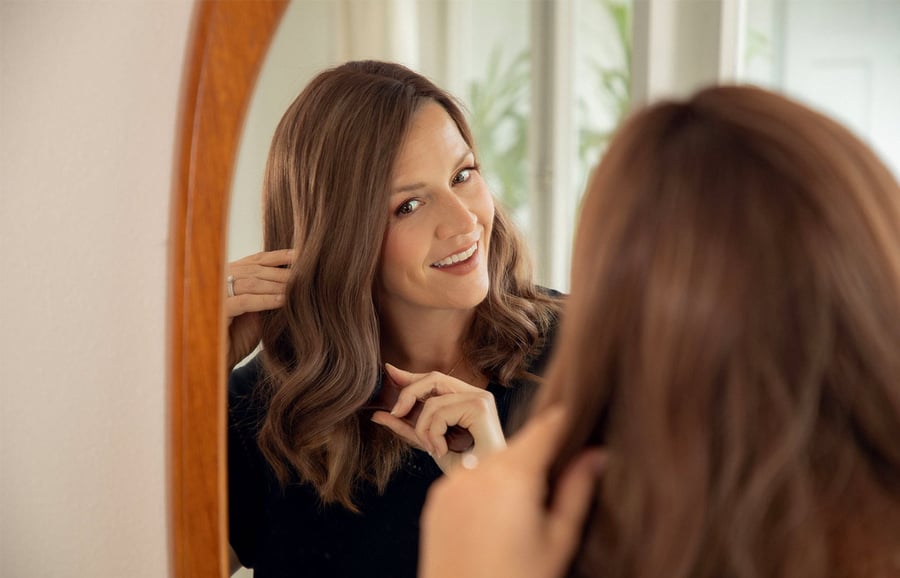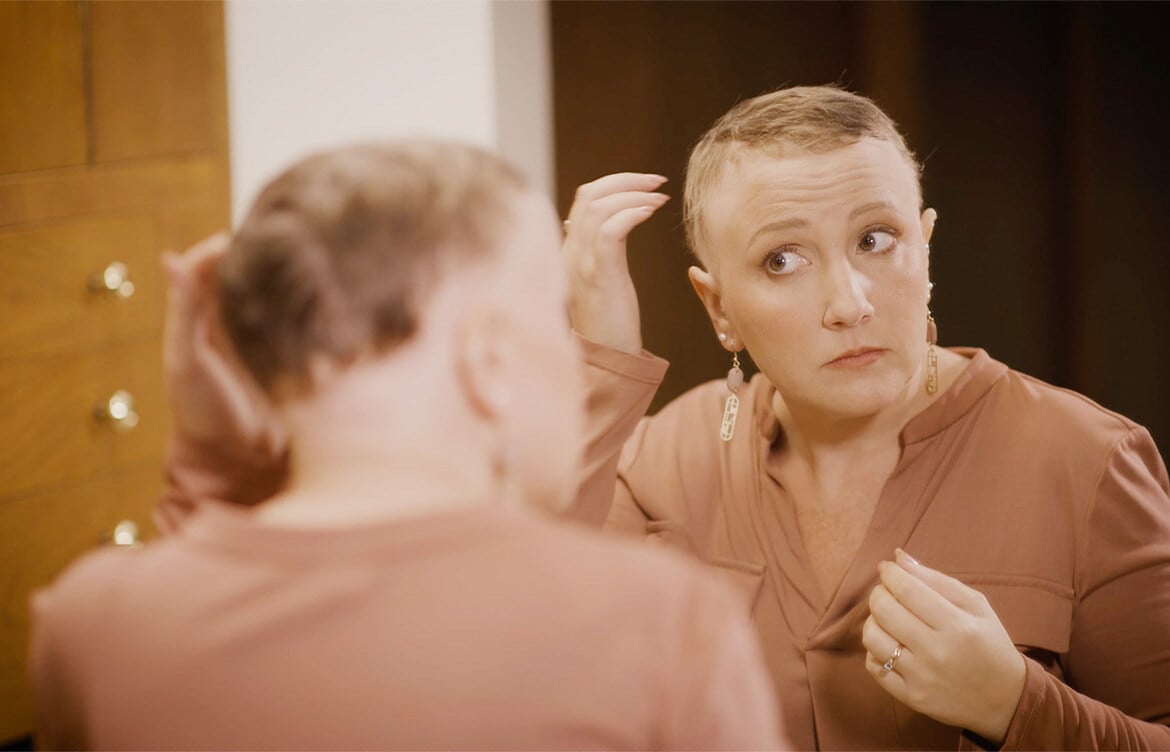Wearing a wig looks great, but could it be hurting your natural hair? It’s a common concern, especially for anyone new to wearing wigs or dealing with hair loss. You might hear conflicting advice - some say wigs are totally safe, while others warn they can cause breakage or hair loss. So, what’s the truth?
In this article, we’ll cut through the myths and get straight to the facts. Whether you’re worried about friction, adhesives, or how often you should take your wig off, we’ll address your concerns and share practical tips for keeping your hair healthy while enjoying the versatility wigs offer.
Our goal is simple: to help you understand how to wear wigs safely, protect your natural hair, and avoid any common pitfalls along the way. Let’s debunk those myths and give you the confidence to rock your wig without worry!
Common Myths About Wigs and Hair Damage

When it comes to wearing wigs, there’s no shortage of myths that can make you hesitant to try them or leave you worried about your natural hair. Let’s break down three of the most common misconceptions and set the record straight with the facts.
Myth #1: Wigs cause permanent hair loss
This is one of the biggest fears people have, but here’s the truth: wigs don’t directly cause permanent hair loss. If you’re experiencing hair loss, it’s likely due to other factors, such as medical conditions (like alopecia or hormonal changes) or improper hair care routines. Wearing a wig is not the culprit - it’s how you care for your hair underneath that matters.
Myth #2: Wigs suffocate your scalp and inhibit hair growth
It might seem logical to think that covering your scalp could stop it from “breathing,” but here’s the good news: your scalp doesn’t need to breathe! Hair growth isn’t affected by air exposure. Instead, it depends on factors like diet, hormones, and keeping your scalp clean and healthy. Wearing a wig won’t suffocate your scalp, as long as you’re taking care of it properly underneath.

Myth #3: Wigs cause friction that leads to hair breakage
This one has a bit of truth to it, but only if the wig isn’t fitted or maintained correctly. Poorly made low-quality wigs or wearing them without proper preparation (like using a wig cap or securing your hair underneath) can cause rubbing, which might lead to breakage over time. However, with the right fit and some simple care tips, you can easily prevent this issue.
By understanding the facts behind these myths, you can confidently enjoy the many benefits of wigs without unnecessary worry. The key is learning how to wear them the right way - and that’s exactly what we’ll cover next!
How Wigs Can Potentially Damage Hair (If Not Worn Properly)

Wigs are a fantastic way to change up your look or protect your natural hair, but like anything, they need to be used correctly. When wigs aren’t worn properly, they can lead to some hair or scalp issues. Here are a few things to watch out for and how they might cause problems.
Improper Fit
If your wig is too tight, it can create unnecessary tension on your scalp and hairline. Over time, this constant pulling can lead to a condition called traction alopecia, which is hair loss caused by stress on the hair follicles. The good news? A properly fitted wig, adjusted to your head size and shape, can prevent this entirely.
Neglecting Scalp Care
Because wigs cover your scalp, it’s easy to forget that the skin underneath still needs love! Failing to wash your scalp, moisturize, or give it some breathing room can lead to dryness, irritation, and even dandruff. Regularly caring for your scalp—even if it’s hidden under a wig—is key to keeping it healthy.
Overuse of Adhesives or Clips
Wig adhesives and clips are useful for keeping your wig secure, but overdoing it can weaken your hair roots or cause breakage. Using these tools sparingly and removing them gently can help avoid unnecessary damage. If possible, look for alternatives like wig grips or adjustable straps for a gentler hold.
The Benefits of Wearing Wigs

Wigs can do wonders for your natural hair and confidence. Let’s talk about some of the biggest benefits of wearing wigs and why they can be a great option for anyone, whether you’re protecting your natural hair or trying something new.
Protective Styling
One of the best things about wigs is how they can act as a barrier for your natural hair. Whether it’s harsh sun, pollution, or cold weather, wigs can shield your hair from these environmental stressors. This helps reduce wear and tear on your natural strands, allowing them to stay healthier over time.
Reduced Heat Damage
Tired of reaching for the flat iron or curling wand? With a human hair wig, you can style the hairpiece instead of your own hair, giving your natural locks a much-needed break. This means less exposure to heat tools, which helps prevent dryness, breakage, and split ends.
Boost Confidence
For anyone dealing with hair loss, thinning hair, or a bad haircut, wigs offer an easy and effective solution. They let you experiment with styles, colors, and lengths without any permanent changes. Best of all, they can help you feel like the best version of yourself - confident, comfortable, and ready to take on the world.

Can I Wear a Wig Without Damaging My Hair?
Wigs are a fantastic tool for style, confidence, and even protecting your natural hair - and the good news is that wigs themselves don’t cause damage to your hair. Issues like breakage or irritation only happen when wigs are worn improperly or without the right precautions. With proper fit, regular scalp care, and mindful use of adhesives or clips, you can wear wigs safely and keep your natural hair healthy.
So, whether you’re exploring wigs to address hair loss or simply to try out new looks, there’s no need to worry. Wigs are a safe, versatile, and empowering option for everyone.
Ready to dive deeper? Check out our beginner’s wig buying guide for tips on choosing your first wig. Or, if you’re still unsure, schedule a free consultation with one of our wig experts to find the perfect fit and learn how to make the most of your new look. Your hair journey can be as exciting and worry-free as you want it to be - let’s make it happen!

Frequently Asked Questions (FAQs)
A: Can wearing a wig every day damage my hair?
A: Wearing a wig every day does not inherently damage your natural hair, provided you follow proper wig-wearing practices. Consistently wearing a wig without giving your hair and scalp adequate care can lead to issues such as tension on the hair follicles, dryness, or irritation. To prevent potential damage:
Ensure Proper Fit A well-fitted wig reduces unnecessary pulling and friction.
Take Wig Breaks Allow your scalp to breathe by taking breaks from wearing the wig.
Maintain Scalp Health Regularly cleanse and moisturize your scalp to keep it healthy underneath the wig.
Use Gentle Adhesives If using adhesives or clips, opt for those that are less likely to cause strain or breakage and apply them carefully.
Q: What type of wig cap is best for preventing hair damage?
A: The best wig cap for preventing hair damage is one that offers comfort, breathability, and a secure fit without causing excessive tension. Here are some top choices:
Lace Front Caps These provide a natural-looking hairline and are lightweight, reducing friction and pressure on the scalp.
Natural Lace Caps Materials that are gentle on the hair minimize breakage and reduce static. They’re also breathable and allow better air circulation to keep the scalp cool and reduce sweat buildup.
Adjustable Caps Wig caps with adjustable straps or closures ensure a snug fit without being too tight and prevent traction alopecia.
Q: How often should I wash my natural hair when wearing wigs regularly?
A: When wearing wigs regularly, it's important to maintain a consistent hair-washing routine to keep your natural hair and scalp healthy. Generally, you should:
Wash Your Natural Hair Every 7 to 10 Days This frequency helps remove buildup from sweat, oils, and any hair products used underneath the wig.
Scalp Cleansing Even if your natural hair is short or you have thinning hair, gently cleanse your scalp to prevent dryness and irritation.
Moisturize After washing, apply a lightweight moisturizer or leave-in conditioner to keep your scalp hydrated.
However, the exact frequency can vary based on your hair type, scalp condition, and personal preferences. If you notice signs of buildup, itchiness, or dryness, consider adjusting your washing schedule accordingly. Additionally, always ensure your natural hair is completely dry before putting on a wig to prevent moisture-related issues.


.jpeg)
